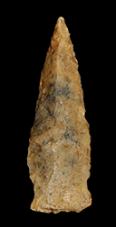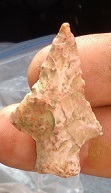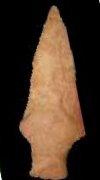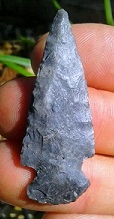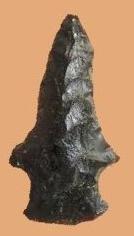Outline is Representative of Size and Shape:
 Subtype
3
Subtype
3
 Subtype
2
Subtype
2
 Subtype
1
Subtype
1
 Subtype
3
Subtype
3 Subtype
2
Subtype
2 Name Details:
Identified By: Ripley P. Bullen
Named For:
Date Identified: 1951
Type Site: The Terra Ceia Site, Manatee County, Florida
Identified By: Ripley P. Bullen
Named For:
Date Identified: 1951
Type Site: The Terra Ceia Site, Manatee County, Florida
Point Validity:
Valid type
Bullen was a distinguished anthropologist and Curator Emeritus of the Florida Museum of Natural History. He was dedicated to identifying and typing projectile points from Florida. This point was named in a professional publication and is professionally a widely recognized type. This is a valid type.
Bullen was a distinguished anthropologist and Curator Emeritus of the Florida Museum of Natural History. He was dedicated to identifying and typing projectile points from Florida. This point was named in a professional publication and is professionally a widely recognized type. This is a valid type.
Duval Stemmed
Cluster: Description of Physical Characteristics and Flaking Pattern:
This is a thick crudely made spike like small to medium triangular expanding stem point with an elliptical or diamond shaped cross section. The blade is generally excurvate and has a spike like appearance. The shoulders vary from horizontal to having an upward angel. The stem is expanding. The stem ranges from convex to straight and has rounded basal corners. This point has a random flaking pattern.
Size Measurements:
Subtype 1 - This is a side notched point with a shallow notch and a straight base, Bullen identified this types size measurements as length range 45-51 mm, width range 14-19 mm, thickness range 6-11 mm.
Subtype 2 - This is a short stem with a straight base. Bullen identified this types size measurements as length range 40-65 mm, width range 13-18 mm, thickness range 6-9 mm.
Subtype 3 - This is a expanding stem to side notch point with a convex base and the blade may be serrated. Bullen identified this types size measurements as length range 35-70 mm, width range 13-21 mm, thickness range 7-11 mm.
Subtype 1 - This is a side notched point with a shallow notch and a straight base, Bullen identified this types size measurements as length range 45-51 mm, width range 14-19 mm, thickness range 6-11 mm.
Subtype 2 - This is a short stem with a straight base. Bullen identified this types size measurements as length range 40-65 mm, width range 13-18 mm, thickness range 6-9 mm.
Subtype 3 - This is a expanding stem to side notch point with a convex base and the blade may be serrated. Bullen identified this types size measurements as length range 35-70 mm, width range 13-21 mm, thickness range 7-11 mm.
Commonly Utilized Material:
Additional Comments:
This point may proceed the Jackson type point. It has the same distribution as the Jackson type and shares many of the same characteristics (Granger and Granger, 2013).
Schroder (W18) notes the difference between the spike type points found in Georgia and Florida. He points out that the Bradley Spike has a stem that varies from straight to contracting with a pointed base. The Duval point has a straight to bulbous style stem. The Flint River point has a rounded stem. The New Market point has a contracting stem. The Schild point has a short straight to slightly expanding stem, and the Florida Spike has a straight to contracting stem with a straight base. The name Woodland Spike was a term used by Whatley that lumped all the Woodland period spike type points into a single category. Farr credits Whatley for the term Woodland Spike while Schroder credits Jerald Ledbetter for the name.
This point may proceed the Jackson type point. It has the same distribution as the Jackson type and shares many of the same characteristics (Granger and Granger, 2013).
Schroder (W18) notes the difference between the spike type points found in Georgia and Florida. He points out that the Bradley Spike has a stem that varies from straight to contracting with a pointed base. The Duval point has a straight to bulbous style stem. The Flint River point has a rounded stem. The New Market point has a contracting stem. The Schild point has a short straight to slightly expanding stem, and the Florida Spike has a straight to contracting stem with a straight base. The name Woodland Spike was a term used by Whatley that lumped all the Woodland period spike type points into a single category. Farr credits Whatley for the term Woodland Spike while Schroder credits Jerald Ledbetter for the name.
Distribution: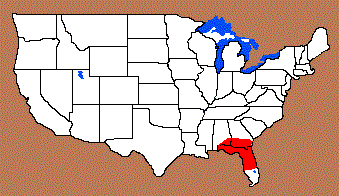
Distribution Comments:
This point is primarily found in central Florida and into southern Georgia and southeastern Alabama.
This point is primarily found in central Florida and into southern Georgia and southeastern Alabama.
Age / Periods:
Date: 1,500 - 1,100 B.P.
Cultural Period: Late Woodland to Mississippian
Glacial Period: Roman Warm to Vandal Minimum
Culture: Weeden Island Culture
Date: 1,500 - 1,100 B.P.
Cultural Period: Late Woodland to Mississippian
Glacial Period: Roman Warm to Vandal Minimum
Culture: Weeden Island Culture
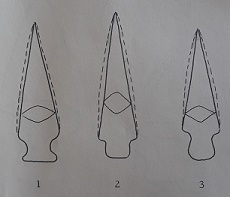 Sub-types as illustrated by Bullen 1975
Sub-types as illustrated by Bullen 1975 Other points in this cluster / Related / Associated Points:

